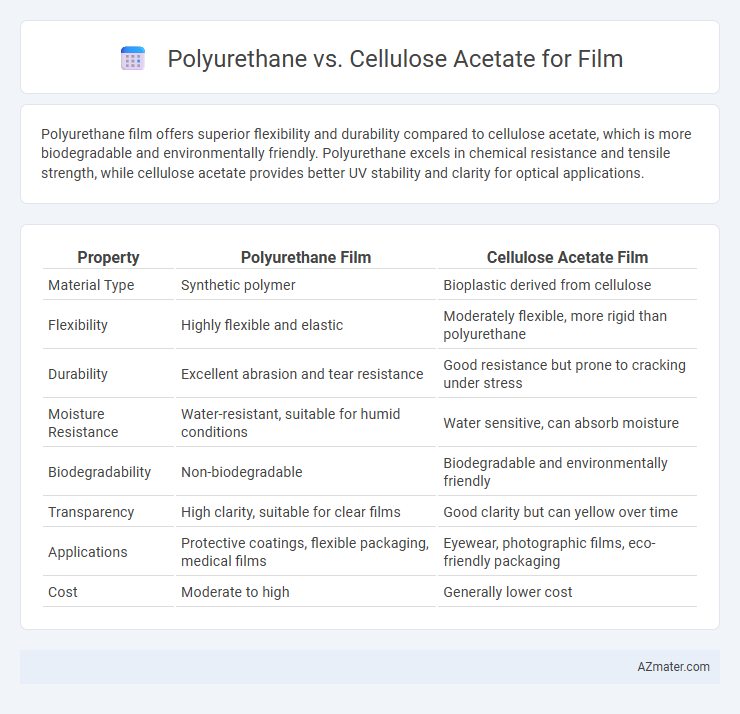Polyurethane film offers superior flexibility and durability compared to cellulose acetate, which is more biodegradable and environmentally friendly. Polyurethane excels in chemical resistance and tensile strength, while cellulose acetate provides better UV stability and clarity for optical applications.
Table of Comparison
| Property | Polyurethane Film | Cellulose Acetate Film |
|---|---|---|
| Material Type | Synthetic polymer | Bioplastic derived from cellulose |
| Flexibility | Highly flexible and elastic | Moderately flexible, more rigid than polyurethane |
| Durability | Excellent abrasion and tear resistance | Good resistance but prone to cracking under stress |
| Moisture Resistance | Water-resistant, suitable for humid conditions | Water sensitive, can absorb moisture |
| Biodegradability | Non-biodegradable | Biodegradable and environmentally friendly |
| Transparency | High clarity, suitable for clear films | Good clarity but can yellow over time |
| Applications | Protective coatings, flexible packaging, medical films | Eyewear, photographic films, eco-friendly packaging |
| Cost | Moderate to high | Generally lower cost |
Introduction to Film Materials: Polyurethane vs Cellulose Acetate
Polyurethane offers superior durability, flexibility, and chemical resistance, making it ideal for high-performance film applications requiring elasticity and strength. Cellulose acetate provides excellent clarity, biodegradability, and ease of processing, commonly used in photographic and packaging films where environmental sustainability is prioritized. Choosing between polyurethane and cellulose acetate depends on the specific functional requirements, such as mechanical properties, environmental impact, and optical clarity in film materials.
Chemical Composition and Structure Comparison
Polyurethane is a polymer composed of organic units joined by carbamate (urethane) links, featuring a flexible, segmented structure that provides excellent durability and elasticity in film applications. Cellulose acetate, derived from cellulose, consists of acetylated glucose units forming a rigid, semi-crystalline polymer with high transparency and biodegradability. The chemical composition of polyurethane offers superior mechanical strength and chemical resistance, whereas cellulose acetate excels in biodegradability and optical clarity due to its natural polymer backbone.
Mechanical Strength and Durability
Polyurethane films exhibit superior mechanical strength and flexibility due to their elastomeric properties, making them highly resistant to tears and abrasion. In contrast, cellulose acetate films offer moderate tensile strength but tend to be more brittle and prone to cracking under prolonged stress or environmental exposure. Durability-wise, polyurethane provides enhanced resistance to moisture, chemicals, and UV degradation, ensuring longer lifespan in demanding applications compared to cellulose acetate.
Flexibility and Handling Characteristics
Polyurethane offers superior flexibility and durability compared to cellulose acetate, making it ideal for applications requiring repeated bending and handling. Cellulose acetate, while less flexible, provides excellent clarity and a smoother surface finish but tends to be more brittle and prone to cracking under stress. The handling characteristics of polyurethane include enhanced resistance to deformation and longer lifespan in dynamic environments, whereas cellulose acetate is favored for its lightweight and ease of processing.
Optical Clarity and Transparency
Polyurethane films exhibit high optical clarity with excellent light transmission, making them ideal for applications requiring transparent and clear materials. Cellulose acetate offers good transparency but often shows slight haze due to its intrinsic birefringence and moisture sensitivity, which can reduce overall optical quality. Polyurethane's superior resistance to yellowing and environmental stress enhances long-term transparency compared to cellulose acetate films.
Environmental Impact and Biodegradability
Polyurethane films, derived from petrochemicals, tend to have a significant environmental footprint due to their non-biodegradable nature and the release of toxic substances during production and disposal. In contrast, cellulose acetate films are produced from renewable plant-based sources like wood pulp, offering enhanced biodegradability and reduced environmental impact. Life cycle assessments highlight cellulose acetate as a more sustainable choice for film applications, promoting eco-friendly waste management and lower carbon emissions.
Resistance to Moisture and Temperature
Polyurethane films exhibit superior resistance to moisture and maintain structural integrity at temperatures ranging from -40degC to 80degC, making them ideal for environments with high humidity and temperature fluctuations. Cellulose acetate, while offering good resistance to moisture, tends to be more sensitive to heat, typically softening above 70degC and degrading faster under prolonged moisture exposure. For applications requiring robust moisture barrier properties and thermal stability, polyurethane provides enhanced durability compared to cellulose acetate.
Applications in Photography and Cinematography
Polyurethane film offers superior flexibility, chemical resistance, and durability, making it ideal for protective coatings in photography and cinematography equipment. Cellulose acetate film, historically popular for its clarity and ease of processing, is commonly used in traditional film stocks but is prone to degradation over time due to acetate decay. Modern applications favor polyurethane for longevity and mechanical strength, whereas cellulose acetate remains significant for archival and artistic film production.
Cost Analysis and Availability
Polyurethane film typically incurs higher production costs compared to cellulose acetate due to complex synthesis and raw material expenses, while cellulose acetate benefits from widespread availability and lower pricing driven by established supply chains. Cellulose acetate's renewable origin and ease of processing contribute to its cost-effectiveness, making it a preferred choice for budget-sensitive applications. Polyurethane offers superior durability and flexibility but at a premium cost, limiting its use where cost constraints are critical.
Conclusion: Choosing the Right Film Material
Polyurethane offers superior flexibility, durability, and chemical resistance, making it ideal for applications requiring high performance and longevity. Cellulose acetate provides excellent optical clarity and biodegradability, suitable for environmentally conscious projects with moderate mechanical demands. Selecting the right film material depends on balancing performance requirements, environmental impact, and cost considerations to achieve optimal results.

Infographic: Polyurethane vs Cellulose acetate for Film
 azmater.com
azmater.com